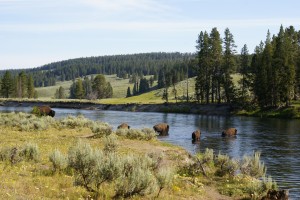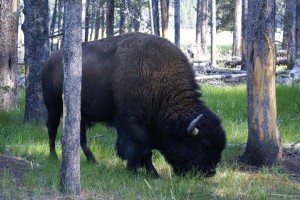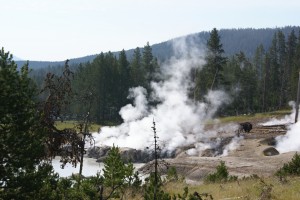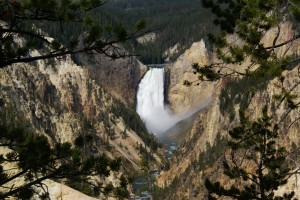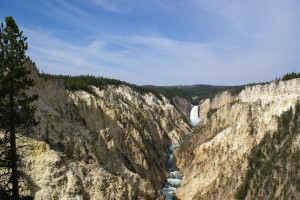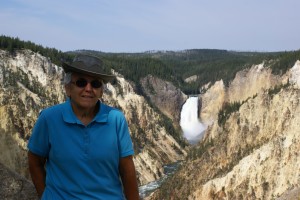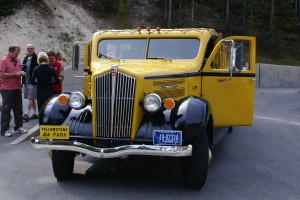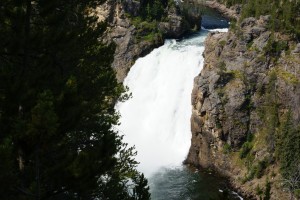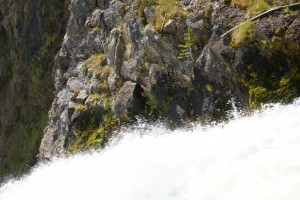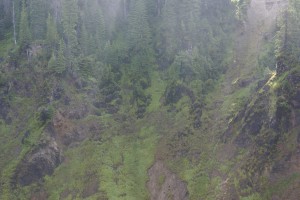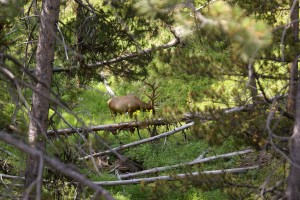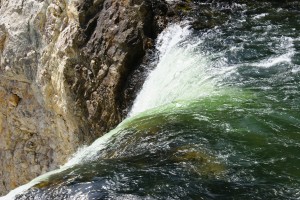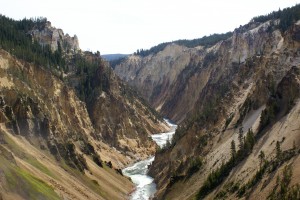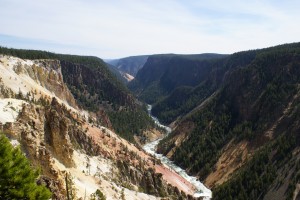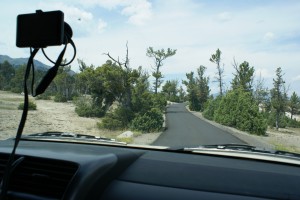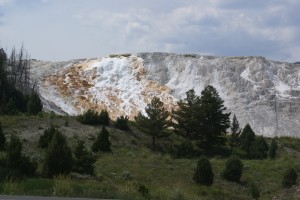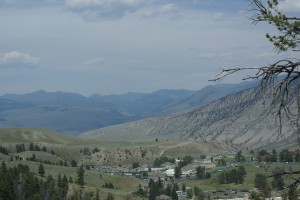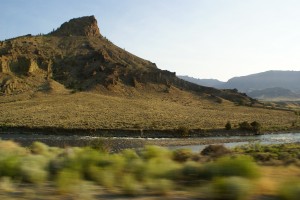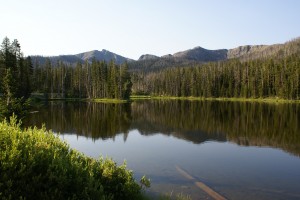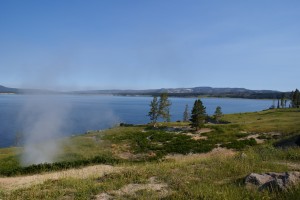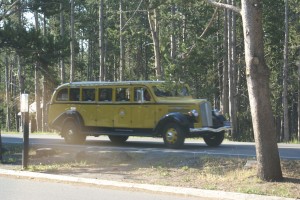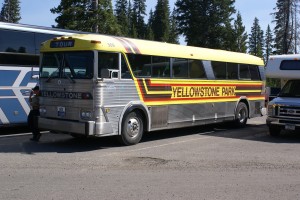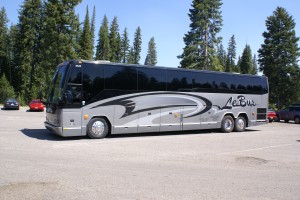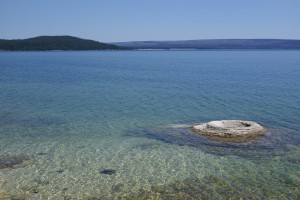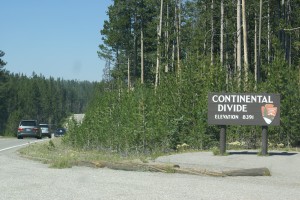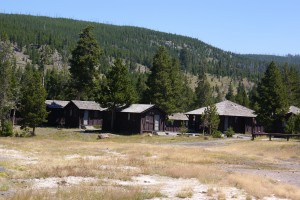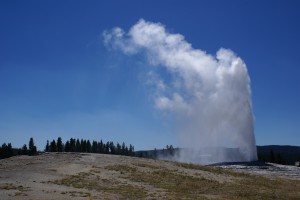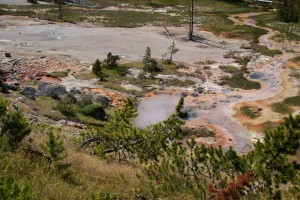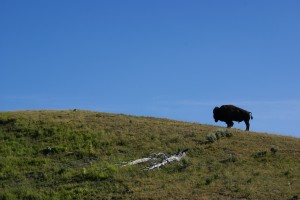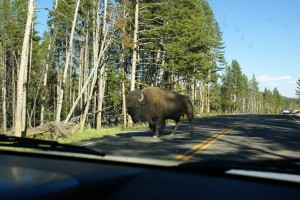We have had an intense but wonderful week in northwest Wyoming and the Green Creek Inn and RV Park has been just the right spot for us to base camp. The RV park is away from the hustle and bustle of Cody, yet close enough to be convenient for shopping and entertainment, and is close enough to Yellowstone N. P. and Grand Teton N. P. to make them accessible as day trips. And although it’s a small RV park with only nine sites, we had excellent full hookups, laundry facilities, a WiFi connection to the Internet, and free popcorn. Our 50 Amp site allowed us to run all three house air-conditioners all day while we were away to keep our cats safe and comfortable. We needed to do this because of daytime highs in the mid-80’s with bright sunshine and constant wind that prevented us from using our awnings to shade the passenger side of the coach.
Although $45 per night is more than we generally pay to stay in an RV park, it was a fair price given the location and facilities. The WiFi/Internet bandwidth was limited, but we were glad to have what we had as there was no useable Verizon 4G/LTE signal here, and even 3G EVDO was marginal for making phone calls. The WiFi connection was generally very strong thanks in part to or WiFi Ranger Mobile Titanium, which has been working very well for us since we bought it at the FMCA rally in Gillette, WY last month. Interestingly, the only OTA television signal we could pick up was Wyoming PBS from the general direction of Cody. (Smile)
This was a quieter day for us, but by no means an idle one, as we needed to prepare for our departure tomorrow morning. We noticed this morning that it was overcast, the first time since we arrived here a week ago. We did have clouds today, and a few drops of rain, but Jeff informed us that the haze we were seeing was from the various forest fires burning in the west.
Linda drove to Cody in the morning to do our shopping. The main attraction was the local Farmers Market, located, conveniently enough, in the parking lot of the Whole Foods Trading Company. She came back with quite a few bags of stuff!
While she was gone I drained the waste tanks, stowed the hose, and added our Pine Sol / water / Calgon solution to the tanks. I also drained the little bit of fresh water that was still in the tank, flushed it with a bit more, and then refilled it. I left the fresh water shore line connected so we could use if until we depart, conserving our onboard water for use on down the road. I also worked on getting our blog postings up-to-date.
When Linda got back she did the laundry. At our house in Michigan this is usually my chore, but for some reason she seems to take care of it on the road. Although we are trying to learn not to over-plan, we are not full-timers, and we have a house and family to which we have to return from time-to-time. We knew the route we wanted to take back to S. E. Michigan, but the timing and overnight waypoints were still undecided. We want to see the Theodore Roosevelt N. P. in western North Dakota, but the campgrounds there do not have any hookups and do not appear to be big rig friendly. Medora, ND is the closest town, but it is 410 miles driving distance from Wapiti. That is more than we care to do in one day, especially given our planned stop at Interstate Power Systems in Billings, MT to visit with Cherie and Chris of Technomadia. (http://www.technomadia.com).
Using the online Good Sam campground finder we located the Meadows RV Park in Miles City, MT, 280 miles away, and made a reservation for tomorrow night. That should give us a 5.5 -6.0 hour drive, leaving plenty of time to stop and visit in Billings.
I continued to work on our blog while Linda paid our bills and continued to research overnight stops. We decided we would try to stay two nights at an RV park in Medora if we could find an opening. And we did! We made a reservation at the Red Trail RV Park just off I-94. It is walking distance to downtown Medora and convenient to the Theodore Roosevelt N. P., which we will now have a day-and-a-half to explore.
Linda took time out to make wheat berry risotto with mushroom /garlic/onion /asparagus. She used some of the Argentinean Malbec wine we had on board, and served the rest with the meal. This was a fragrant, earthy dish with great “chew” that somehow fit the wildness of this past week. When she has the time to cook we eat very well indeed.
While the risotto was cooking we pulled the tray on the passenger side of the bus that houses the chassis battery disconnect switches and the Vanner equalizers (we have two as it turns out). We located the circuit breakers, and pushed them in to (possibly) reset them. (This refers back to the BAL light that came on while traveling from Sheridan to Wapiti on the 21st of this month.)
Beyond Medora we hope to stay at a winery in Buffalo, ND about 30 miles west of Fargo. It was personally recommended to us by Harvest Host founders Don and Kim Greene. If they can accommodate us on the 31st, it will be our first use of our Harvest Hosts membership.
Along the same lines, we hope to stay the next night at the Forest Edge Winery in Laporte, Minnesota. Forest Edge is owned/operated by members of the FMCA Freethinkers Associate Chapter. Being a kind of “virtual” chapter in FMCA’s International Area (INTO) our members are spread out all over the United States, Canada, and Mexico. Rallies are difficult to organize and most of our interactions are by e-mail. We even hold our annul business meeting electronically. Thus any opportunity to meet in person is a treat. The fact that Forest Edge is also a Harvest Host business makes it easier and that much more special.
From Laporte we plan to head to Hibbing, MN to visit the Greyhound Bus Museum. Beyond that, we will make our way across Minnesota, Wisconsin, and the Upper Peninsula of Michigan to St. Ignace. From there we cross the Straits of Mackinaw (Mackinac) on the Mackinaw Bridge and head straight south on I-75 where we vector off on US-23 southbound to M-59, and home. Depending on when we get there we will have been gone almost exactly two months.
